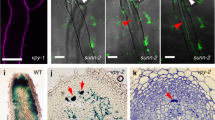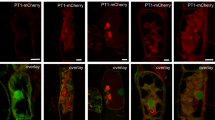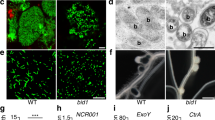Abstract
Symbioses between legumes and rhizobia require establishment of the plant-derived symbiosome membrane, which surrounds the rhizobia and accommodates the symbionts by providing an interface for nutrient and signal exchange. The host cytoskeleton and endomembrane trafficking systems play central roles in the formation of a functional symbiotic interface for rhizobia endosymbiosis; however, the underlying mechanisms remain largely unknown. Here we demonstrate that the nodulation-specific kinesin-like calmodulin-binding protein (nKCBP), a plant-specific microtubule-based kinesin motor, controls central vacuole morphogenesis in symbiotic cells in Medicago truncatula. Phylogenetic analysis further indicated that nKCBP duplication occurs solely in legumes of the clade that form symbiosomes. Knockout of nKCBP results in central vacuole deficiency, defective symbiosomes and abolished nitrogen fixation. nKCBP decorates linear particles along microtubules, and crosslinks microtubules with the actin cytoskeleton, to control central vacuole formation by modulating vacuolar vesicle fusion in symbiotic cells. Together, our findings reveal that rhizobia co-opted nKCBP to achieve symbiotic interface formation by regulating cytoskeletal assembly and central vacuole morphogenesis during nodule development.
This is a preview of subscription content, access via your institution
Access options
Access Nature and 54 other Nature Portfolio journals
Get Nature+, our best-value online-access subscription
$29.99 / 30 days
cancel any time
Subscribe to this journal
Receive 12 digital issues and online access to articles
$119.00 per year
only $9.92 per issue
Buy this article
- Purchase on Springer Link
- Instant access to full article PDF
Prices may be subject to local taxes which are calculated during checkout






Similar content being viewed by others
Data availability
All data generated in this study are included within the main text and supplementary information. The MtnKCBP gene can be found at Phytozome (https://phytozome-next.jgi.doe.gov/report/gene/Mtruncatula_Mt4_0v1/Medtr5g025100). Protein sequences in Fig. 1d for the phylogenetic analysis and in Supplementary Fig. 6 for the pairwise sequence alignment are accessible either at NCBI (https://blast.ncbi.nlm.nih.gov/Blast.cgi) or at Phytozome (https://phytozome-next.jgi.doe.gov/), with gene IDs provided in Fig. 1d and Supplementary Fig. 6 legends. All experimental materials generated in this work are available from the corresponding author upon request. Source data are provided with this paper.
References
Martin, F. M., Uroz, S. & Barker, D. G. Ancestral alliances: plant mutualistic symbioses with fungi and bacteria. Science 356, aad450 (2017).
Suzaki, T., Yoro, E. & Kawaguchi, M. Leguminous plants: inventors of root nodules to accommodate symbiotic bacteria. Int. Rev. Cel. Mol. Bio. 316, 111–158 (2015).
Xiao, T. T. et al. Fate map of Medicago truncatula root nodules. Development 141, 3517–3528 (2014).
Franssen, H. J. et al. Root developmental programs shape the Medicago truncatula nodule meristem. Development 142, 2941–2950 (2015).
Roy, S. et al. Celebrating 20 years of genetic discoveries in legume nodulation and symbiotic nitrogen fixation. Plant Cell 32, 15–41 (2020).
Oldroyd, G. E., Murray, J. D., Poole, P. S. & Downie, J. A. The rules of engagement in the legume-rhizobial symbiosis. Annu. Rev. Genet. 45, 519–546 (2011).
Oldroyd, G. E. & Downie, J. A. Coordinating nodule morphogenesis with rhizobial infection in legumes. Annu. Rev. Plant Biol. 59, 519–546 (2008).
Desbrosses, G. J. & Stougaard, J. Root nodulation: a paradigm for how plant–microbe symbiosis influences host developmental pathways. Cell Host Microbe 10, 348–358 (2011).
Ferguson, B. J. et al. Molecular analysis of legume nodule development and autoregulation. J. Integr. Plant Biol. 52, 61–76 (2010).
Gavrin, A. et al. VAMP721a and VAMP721d are important for pectin dynamics and release of bacteria in soybean nodules. N. Phytol. 210, 1011–1021 (2016).
Jayaraman, D., Gilroy, S. & Ane, J. M. Staying in touch: mechanical signals in plant–microbe interactions. Curr. Opin. Plant Biol. 20, 104–109 (2014).
Gavrin, A., Kulikova, O., Bisseling, T. & Fedorova, E. E. Interface symbiotic membrane formation in root nodules of Medicago truncatula: the role of synaptotagmins MtSyt1, MtSyt2 and MtSyt3. Front. Plant Sci. 8, 201–210 (2017).
Brandizzi, F. & Wasteneys, G. O. Cytoskeleton-dependent endomembrane organization in plant cells: an emerging role for microtubules. Plant J. 75, 339–349 (2013).
Mathur, J. & Hulskamp, M. Microtubules and microfilaments in cell morphogenesis in higher plants. Curr. Biol. 12, R669–R676 (2002).
Zhang, X. X. et al. The host actin cytoskeleton channels rhizobia release and facilitates symbiosome accommodation during nodulation in Medicago truncatula. N. Phytol. 221, 1049–1059 (2018).
Gavrin, A., Jansen, V., Ivanov, S., Bisseling, T. & Fedorova, E. ARP2/3-mediated actin nucleation associated with symbiosome membrane is essential for the development of symbiosomes in infected cells of Medicago truncatula root nodules. Mol. Plant Microbe Interact. 28, 605–614 (2015).
Kitaeva, A. B., Demchenko, K. N., Tikhonovich, I. A., Timmers, A. C. & Tsyganov, V. E. Comparative analysis of the tubulin cytoskeleton organization in nodules of Medicago truncatula and Pisum sativum: bacterial release and bacteroid positioning correlate with characteristic microtubule rearrangements. N. Phytol. 210, 168–183 (2016).
Zhang, C., Hicks, G. R. & Raikhel, N. V. Plant vacuole morphology and vacuolar trafficking. Front. Plant Sci. 5, 476 (2014).
Gavrin, A. et al. Adjustment of host cells for accommodation of symbiotic bacteria: vacuole defunctionalization, HOPS suppression, and TIP1g retargeting in Medicago. Plant Cell 26, 3809–3822 (2014).
Parniske, M. Uptake of bacteria into living plant cells, the unifying and distinct feature of the nitrogen-fixing root nodule symbiosis. Curr. Opin. Plant Biol. 44, 164–174 (2018).
Reddy, V. S. & Reddy, A. S. N. A plant calmodulin-binding motor is part kinesin and part myosin. Bioinformatics 15, 1055–1057 (1999).
Abdel-Ghany, S. E., Day, I. S., Simmons, M. P., Kugrens, P. & Reddy, A. S. N. Origin and evolution of kinesin-like calmodulin-binding protein. Plant Physiol. 138, 1711–1722 (2005).
Reddy, A. S. N., Safadi, F., Narasimhulu, S. B., Golovkin, M. & Hu, X. A novel plant calmodulin-binding protein with a kinesin heavy chain motor domain. J. Biol. Chem. 271, 7052–7060 (1996).
Tian, J. et al. Orchestration of microtubules and the actin cytoskeleton in trichome cell shape determination by a plant-unique kinesin. eLife 4, e09351 (2015).
Rensing, S. A. Plant Evo-Devo: how tip growth evolved. Curr. Biol. 26, R1228–R1230 (2016).
Honkanen, S. et al. The mechanism forming the cell surface of tip-growing rooting cells is conserved among land plants. Curr. Biol. 26, 3238–3244 (2016).
Breakspear, A. et al. The root hair ‘infectome’ of Medicago truncatula uncovers changes in cell cycle genes and reveals a requirement for auxin signaling in rhizobial infection. Plant Cell 26, 4680–4701 (2014).
Carrere, S., Verdier, J. & Gamas, P. MtExpress, a comprehensive and curated RNAseq-based gene expression atlas for the model legume Medicago truncatula. Plant Cell Physiol. 62, 1494–1500 (2021).
Zhang, T. et al. Sequencing of allotetraploid cotton (Gossypium hirsutum L. acc. TM-1) provides a resource for fiber improvement. Nat. Biotechnol. 33, 531–537 (2015).
Bolsheva, N. L. et al. Evolution of blue-flowered species of genus Linum based on high-throughput sequencing of ribosomal RNA genes. BMC Evol. Biol. 17, 253 (2017).
Dai, X. et al. The willow genome and divergent evolution from poplar after the common genome duplication. Cell Res. 24, 1274–1277 (2014).
Schmutz, J. et al. Genome sequence of the palaeopolyploid soybean. Nature 463, 178–183 (2010).
Behm, J. E., Geurts, R. & Kiers, E. T. Parasponia: a novel system for studying mutualism stability. Trends Plant Sci. 19, 757–763 (2014).
Limpens, E. et al. Formation of organelle-like N2-fixing symbiosomes in legume root nodules is controlled by DMI2. Proc. Natl Acad. Sci. USA 102, 10375–10380 (2005).
Jauh, G. Y., Phillips, T. E. & Rogers, J. C. Tonoplast intrinsic protein isoforms as markers for vacuolar functions. Plant Cell 11, 1867–1882 (1999).
Cui, Y. et al. A whole-cell electron tomography model of vacuole biogenesis in Arabidopsis root cells. Nat. Plants 5, 95–105 (2019).
Li, X. X. et al. Large scale three-dimensional reconstruction of an entire Caenorhabditis elegans larva using AutoCUTS-SEM. J. Struct. Biol. 200, 87–96 (2017).
Mathur, J. Mutations in actin-related proteins 2 and 3 affect cell shape development in Arabidopsis. Plant Cell 15, 1632–1645 (2003).
Onelli, E. et al. Microtubules play a role in trafficking prevacuolar compartments to vacuoles in tobacco pollen tubes. Open Biol. 8, 180078 (2018).
Wang, P., Hawkins, T. J. & Hussey, P. J. Connecting membranes to the actin cytoskeleton. Curr. Opin. Plant Biol. 40, 71–76 (2017).
Scheuring, D. et al. Actin-dependent vacuolar occupancy of the cell determines auxin-induced growth repression. Proc. Natl Acad. Sci. USA 113, 452–457 (2016).
Maekawa, T. et al. Polyubiquitin promoter-based binary vectors for overexpression and gene silencing in Lotus japonicus. Mol. Plant Microbe Interact. 21, 375–382 (2008).
Qiu, L. P. et al. SCARN a novel class of SCAR protein that is required for root-hair infection during legume nodulation. PLoS Genet. 11, e1005623 (2015).
Kruger, F. & Schumacher, K. Pumping up the volume—vacuole biogenesis in Arabidopsis thaliana. Semin. Cell Dev. Biol. 80, 106–112 (2018).
Zouhar, J. & Rojo, E. Plant vacuoles: where did they come from and where are they heading? Curr. Opin. Plant Biol. 12, 677–684 (2009).
Oda, Y. et al. Microtubules regulate dynamic organization of vacuoles in Physcomitrella patens. Plant Cell Physiol. 50, 855–868 (2009).
Lazzaro, M. D., Marom, E. Y. & Reddy, A. S. N. Polarized cell growth, organelle motility, and cytoskeletal organization in conifer pollen tube tips are regulated by KCBP, the calmodulin-binding kinesin. Planta 238, 587–597 (2013).
Yamada, M., Tanaka-Takiguchi, Y., Hayashi, M., Nishina, M. & Goshima, G. Multiple kinesin-14 family members drive microtubule minus end-directed transport in plant cells. J. Cell Biol. 216, 1705–1714 (2017).
Jonsson, E., Yamada, M., Vale, R. D. & Goshima, G. Clustering of a kinesin-14 motor enables processive retrograde microtubule-based transport in plants. Nat. Plants 1, 15087 (2015).
Schwab, B. et al. Regulation of cell expansion by the DISTORTED genes in Arabidopsis thaliana: actin controls the spatial organization of microtubules. Mol. Gen. Genet. 269, 350–360 (2003).
Zhang, X., Grey, P. H., Krishnakumar, S. & Oppenheimer, D. G. The IRREGULAR TRICHOME BRANCH loci regulate trichome elongation in Arabidopsis. Plant Cell Physiol. 46, 1549–1560 (2005).
Zhang, X., Dyachok, J., Krishnakumar, S., Smith, L. G. & Oppenheimer, D. G. IRREGULAR TRICHOME BRANCH1 in Arabidopsis encodes a plant homolog of the actin-related protein2/3 complex activator Scar/WAVE that regulates actin and microtubule organization. Plant Cell 17, 2314–2326 (2005).
Smit, P. et al. NSP1 of the GRAS protein family is essential for rhizobial Nod factor-induced transcription. Science 308, 1789–1791 (2005).
Liu, W. et al. Strigolactone biosynthesis in Medicago truncatula and rice requires the symbiotic GRAS-type transcription factors NSP1 and NSP2. Plant Cell 23, 3853–3865 (2011).
Liu, T. et al. Augmin triggers microtubule-dependent microtubule nucleation in interphase plant cells. Curr. Biol. 24, 2708–2713 (2014).
Wang, Q. et al. Transfer cells mediate nitrate uptake to control root nodule symbiosis. Nat. Plants 6, 800–808 (2020).
Yan, L. et al. High-efficiency genome editing in Arabidopsis using YAO promoter-driven CRISPR/Cas9 system. Mol. Plant 8, 1820–1823 (2015).
Grefen, C. et al. A ubiquitin-10 promoter-based vector set for fluorescent protein tagging facilitates temporal stability and native protein distribution in transient and stable expression studies. Plant J. 64, 355–365 (2010).
Wang, C. et al. KTN80 confers precision to microtubule severing by specific targeting of katanin complexes in plant cells. EMBO J. 36, 3435–3447 (2017).
Wang, J. et al. A purple acid phosphatase plays a role in nodule formation and nitrogen fixation in Astragalus sinicus. Plant Mol. Biol. 88, 515–529 (2015).
Lei, L. et al. A nodule-specific lipid transfer protein AsE246 participates in transport of plant-synthesized lipids to symbiosome membrane and is essential for nodule organogenesis in Chinese milk vetch. Plant Physiol. 164, 1045–1058 (2014).
Gonzalez-Rizzo, S., Crespi, M. & Frugier, F. The Medicago truncatula CRE1 cytokinin receptor regulates lateral root development and early symbiotic interaction with Sinorhizobium meliloti. Plant Cell 18, 2680–2693 (2006).
Wang, C. et al. NODULES WITH ACTIVATED DEFENSE 1 is required for maintenance of rhizobial endosymbiosis in Medicago truncatula. N. Phytol. 212, 176–191 (2016).
Han, L. B. et al. The two domains of cotton WLIM1a protein are functionally divergent. Sci. China Life Sci. 59, 206–212 (2016).
Si, Z. Y. et al. Digalactosyldiacylglycerol synthase gene MtDGD1 plays an essential role in nodule development and nitrogen fixation. Mol. Plant Microbe Interact. 32, 1196–1209 (2019).
Sinharoy, S. et al. The C2H2 transcription factor regulator of symbiosome differentiation represses transcription of the secretory pathway gene VAMP721a and promotes symbiosome development in Medicago truncatula. Plant Cell 25, 3584–3601 (2013).
Acknowledgements
We thank R. Li (Southern University of Science and Technology) for helpful discussion. We are grateful to H. Wang, L. Su and Y. Wu (Institute of Microbiology, Chinese Academy of Sciences), for providing technical assistance in imaging. We are grateful to X. Li and X. Tan for helping with sample preparation and taking SEM images at the Center for Biological Imaging (CBI), Institute of Biophysics, Chinese Academy of Science. We are grateful to T. Zhao (Institute of Microbiology, Chinese Academy of Sciences) for the technical assistance of flow cytometry. This study was supported by the Strategic Priority Research Program of the Chinese Academy of Sciences (grant no. XDB27040210), the Strategic Priority Research Program of Chinese Academy of Sciences (grant no. XDA26030105), the Key Research Program from the Chinese Academy of Sciences (grant no. ZDRW-ZS-2019-2), National Transgenic Major Program (grant no. 2019ZX08010-004), CAS Project for Young Scientists in Basic Research (YSBR-011), the National Science Fund for Distinguished Young Scholars (grant no. 31925003), the National Science Foundation of China (grant no. 32000142) and the grants from the State Key Laboratory of Plant Genomics.
Author information
Authors and Affiliations
Contributions
X.Z. designed and performed experiments, analysed the data, prepared figures and videos, and wrote the manuscript. Q.W. participated in experimental design and technical troubleshooting. J.W. participated in the complementary vector constructions. M.Q. participated in sequence blast and phylogenetic analysis. C.Z., Y.H., G.W., H.W., Y.Y., J.T., D.C. and Y.L. provided essential technical assistances. D.W., Y.Z. and Y.X. participated in data interpretation and manuscript organization. Z.K. conceived the project, interpreted the data, and wrote and revised the article.
Corresponding author
Ethics declarations
Competing interests
The authors declare no competing interests.
Peer review
Peer review information
Nature Plants thanks the anonymous reviewers for their contribution to the peer review of this work
Additional information
Publisher’s note Springer Nature remains neutral with regard to jurisdictional claims in published maps and institutional affiliations.
Supplementary information
Supplementary Information
Supplementary Figs. 1–7 and Table 1.
Supplementary Video 1
3D reconstruction of vacuoles in nodule nitrogen-fixing cells using confocal microscopy. Related to Fig. 3g,h.
Supplementary Video 2
3D reconstruction of vacuoles in WT nodule nitrogen-fixing cells. Related to Fig. 3i.
Supplementary Video 3
The whole side-view micrographs of central vacuoles in WT nodule nitrogen-fixing cells. Related to Fig. 3i.
Supplementary Video 4
3D reconstruction of vacuoles in nkcbp nodule nitrogen-fixing cells. Related to Fig. 3j.
Supplementary Video 5
The whole side-view micrographs of central vacuole in nkcbp nodule nitrogen-fixing cells. Related to Fig. 3j.
Supplementary Video 6
3D reconstruction of nKCBP localization in nodule infected cells. Related to Fig. 5a.
Source data
Source Data Fig. 1
Statistical source data for Fig. 1a.
Source Data Fig. 2
Statistical source data for Fig. 2c–e.
Rights and permissions
Springer Nature or its licensor holds exclusive rights to this article under a publishing agreement with the author(s) or other rightsholder(s); author self-archiving of the accepted manuscript version of this article is solely governed by the terms of such publishing agreement and applicable law.
About this article
Cite this article
Zhang, X., Wang, Q., Wu, J. et al. A legume kinesin controls vacuole morphogenesis for rhizobia endosymbiosis. Nat. Plants 8, 1275–1288 (2022). https://doi.org/10.1038/s41477-022-01261-4
Received:
Accepted:
Published:
Issue Date:
DOI: https://doi.org/10.1038/s41477-022-01261-4



